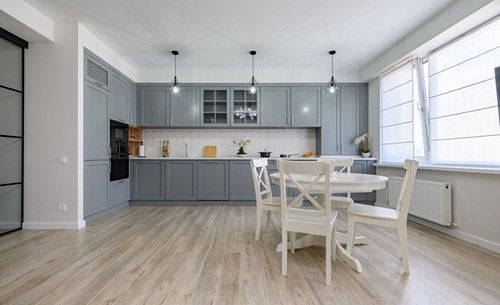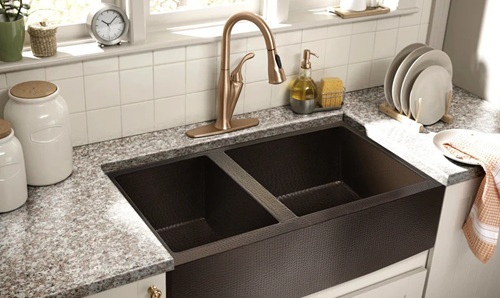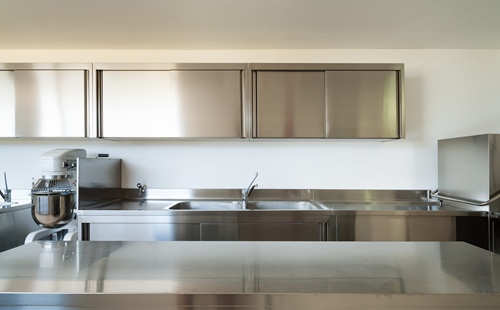Flooring plays a crucial role in defining the look, feel, and functionality of your kitchen. Among the various materials available, laminate flooring has emerged as a popular option for homeowners seeking a stylish yet budget-friendly solution. But is it really suitable for the high-traffic, high-moisture environment of the kitchen?
Lets explore the pros and cons of laminate flooring in the kitchen, helping you make an informed decision based on cost, performance, aesthetics, and maintenance.

What Is Laminate Flooring?
Laminate flooring is a multi-layer synthetic product designed to mimic the appearance of natural materials like hardwood, stone, or tile. It typically consists of:
- Wear Layer: A clear protective topcoat resistant to scratches and stains
- Design Layer: A high-resolution printed image that resembles wood or stone
- Core Layer: Made from high-density fiberboard (HDF) for structural strength
- Backing Layer: Provides moisture resistance and stability
Laminate planks are available in click-lock systems that make them easy to install over a subfloor or existing flooring.
✅ Pros of Laminate Flooring in the Kitchen
1. Affordable and Cost-Effective
One of laminate’s biggest selling points is its budget-friendliness. It offers the aesthetic of hardwood or stone without the hefty price tag.
Cost Comparison (Per Sq. Ft.):
- Laminate: $1–$4 (₹100–₹300)
- Hardwood: $8–$15 (₹500–₹1,000+)
- Tile: $5–$10 (₹300–₹700)
Laminate is a smart choice for homeowners who want a stylish kitchen floor without overspending.
2. Easy Installation
Laminate flooring is designed for DIY installation with interlocking planks (floating floor system). There’s no need for glue or nails, and it can be installed over most subfloors, reducing labor and installation time.
Pro Tip: Opt for laminate with built-in underlayment for added sound absorption and comfort.
3. Wide Range of Styles and Finishes
From rustic oak and whitewashed pine to sleek gray stone and black slate, laminate offers a broad selection of colors, patterns, and textures. Advanced printing technology even mimics wood grain and tile grout lines with stunning realism.
4. Scratch and Stain Resistant
Thanks to its protective wear layer, laminate is highly resistant to scratches, dents, and stains, making it ideal for busy kitchens where pets, kids, or foot traffic are a concern.
Fact: Laminate outperforms hardwood in resisting pet claws and dropped utensils.
5. Low Maintenance
Laminate floors require minimal upkeep. Regular sweeping or vacuuming and occasional mopping with a damp cloth are usually enough. There’s no need for waxing or refinishing like with hardwood.
❌ Cons of Laminate Flooring in the Kitchen
1. Susceptible to Water Damage
Despite having a protective layer, traditional laminate is not waterproof. Excessive moisture can cause the planks to warp, swell, or delaminate. Spills must be wiped up immediately to prevent long-term damage.
Warning: Never install traditional laminate under a sink, dishwasher, or refrigerator without proper sealing.
2. Cannot Be Refinished
Unlike hardwood, which can be sanded and refinished multiple times, laminate flooring has a limited lifespan. Once damaged, the only solution is to replace the planks.
Average Lifespan:
- Traditional laminate: 10–20 years
- Waterproof laminate: 15–25 years
3. Feels Less Authentic
While laminate closely mimics the look of natural wood or stone, it doesn’t quite match the texture, depth, or warmth of real materials. Some homeowners may find it feels hollow or artificial underfoot.
Pro Tip: Use rugs or mats to add warmth and acoustic insulation.
4. Vulnerable to Lifting and Gapping
Improper installation, poor subfloor conditions, or extreme humidity can lead to plank lifting or gaps between boards. It’s essential to acclimate the material and install it properly to prevent issues.
5. Sound and Echo
Laminate can be noisier underfoot than vinyl or carpeted floors. Without a proper underlayment, footsteps and dropped objects may produce echoing or hollow sounds.
⚖️ Laminate vs Other Kitchen Flooring Options
| Feature | Laminate | Vinyl Plank | Hardwood | Tile |
| Water Resistance | Moderate (low if traditional) | High (especially waterproof types) | Low (unless sealed) | Excellent |
| Scratch Resistance | High | Moderate–High | Moderate | High |
| Durability | Moderate–High | High | High (if maintained) | Very High |
| Maintenance | Low | Low | Moderate–High | Low |
| Installation | Easy (DIY-friendly) | Easy | Harder (professional) | Labor-intensive |
| Cost | Low–Moderate | Moderate | High | Moderate–High |
| Style Variety | High | High | High | Moderate |
| Refinishing | Not possible | Not possible | Yes | No |
🛠️ Best Practices for Laminate in the Kitchen
- Choose Waterproof Laminate: For better kitchen performance, invest in waterproof or water-resistant laminate that offers added protection against spills.
- Use Area Rugs and Mats: Place absorbent rugs near the sink, stove, and dishwasher to protect high-risk areas.
- Seal the Edges: Use silicone caulk or waterproof adhesive around the perimeter to prevent water intrusion.
- Clean Spills Immediately: Don’t let water sit on the surface for extended periods.
- Use Felt Pads: Protect against scratches by placing felt pads under chairs and stools.
🏁 Is Laminate Flooring Right for Your Kitchen?
✅ Laminate Flooring Is Ideal If:
- You want a budget-friendly upgrade with a stylish appearance.
- You have a dry, low-moisture kitchen.
- You’re comfortable with light DIY projects.
- You want flooring that’s easy to clean and maintain.
- You’re looking for scratch resistance and design flexibility.
❌ Laminate May Not Be Best If:
- Your kitchen is prone to water spills or leaks.
- You want a floor that can be refinished over time.
- You expect heavy daily usage or messy cooking.
- You prefer the natural feel of real wood or stone.
Final Verdict
Laminate flooring in the kitchen offers a compelling balance of affordability, aesthetics, and ease of installation, especially for homeowners on a budget. It brings the visual appeal of hardwood or tile without the associated costs and is surprisingly resilient to everyday wear and tear.
However, traditional laminate falls short in water resistance, which is a critical factor in kitchens. If you’re considering laminate, invest in waterproof or high-quality versions, follow best practices during installation, and take preventive steps to avoid moisture damage.
With the right product and care, laminate can be a stylish and practical flooring solution that serves your kitchen well for years.

